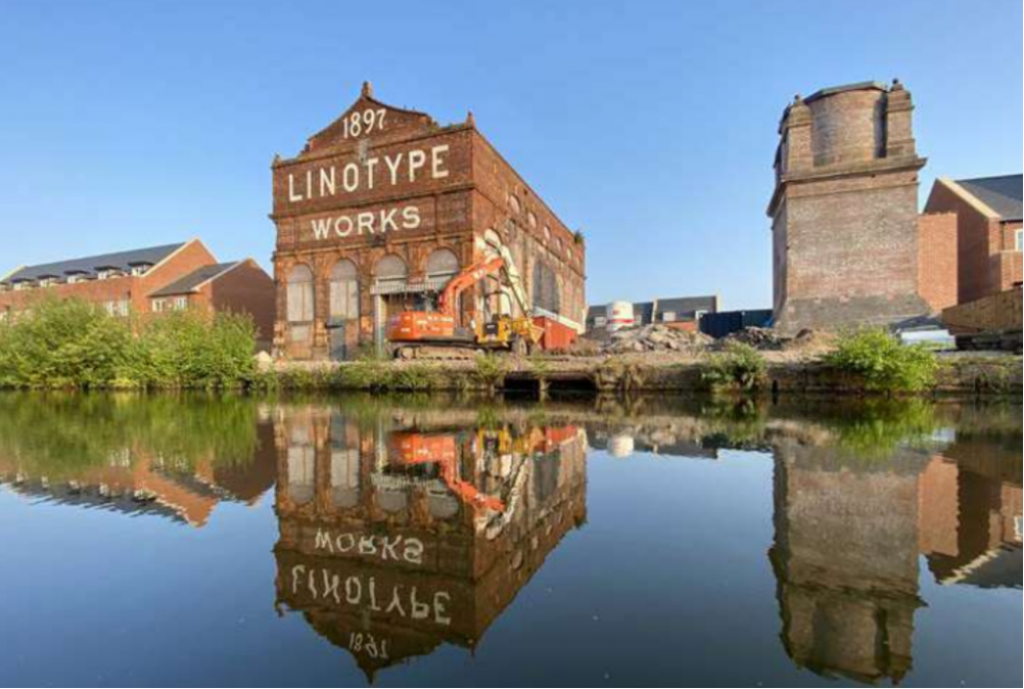PRESS RELEASE: Listing success as Victorian Manchester Engine House saved from demolition
31st July 2021
SAVE is delighted to announce that the Engine House and chimney base of the former Linotype Works in Altrincham has been listed, halting its proposed demolition.
Earlier this year owners of the historic Altrincham Linotype Works, Morris Homes, had applied to demolish and rebuild the unlisted canal-side Engine House as part of their wider redevelopment of the site, which is a designated conservation area.
SAVE considers the Engine House and nearby Chimney base to be of high historic significance and suitable for conversion. In response to the threat of demolition, we submitted a listing application to Historic England, and the building has now been granted grade II listed status by the Department for Culture, Media and Sport. The decision means the owners will now have to apply for Listed Building Consent in order to demolish the listed building.
Marcus Binney, executive president of SAVE Britain’s Heritage said: “The engine house potentially has lovely views up and down the canal. The developers have handsomely restored the main office building of this once vast factory and we encourage them to revert to their original plan of converting the engine house into apartments. These could be the most spectacular apartments on the whole site.”
In their assessment report, Historic England recommend listing on grounds of the buildings' architectural interest, including:
- "the design and architectural display of the large engine house and adjacent chimney base, particularly the quality of the terracotta detailing to both the exterior and interior of the engine house;
- for the inclusion of the works name and date on the principal north façade of the engine house, underlining the building’s integral role in the public view of the complex across the Bridgewater Canal;
- the interior of the engine house retains original decorative wall tiles and a travelling crane in addition to the terracotta detailing;
- the buildings were designed by the renowned Stott & Sons who were employed as company architects, designing both the industrial complex and estate village for the workers, and who have a number of listed industrial buildings to their name including Grade II* cotton mills."
The Engine House was fundamentally important in the production process and housed the source of power for the whole Works, and this was certainly reflected in the level of external architectural decoration.
Formerly part of the Linotype Works, the Engine House and chimney base were built by the Linotype Company in 1897 to manufacture specialist typesetting machinery. Linotype machines were used worldwide, and the company dominated the newspaper industry in the twentieth century. At the height of their success they employed over ten thousand people and supplied machines to 63 countries.
The Engine House and chimney base are among the last remaining fragments of the Works. Other survivals include the impressive flagship Office building, also Grade II listed, and the Linotype Housing Estate, 172 workers’ houses built between 1897 and 1901. These were all designed by the renowned architectural firm Stott & Sons of Manchester, the leading northern cotton mill architects of the period, who were appointed company architects. The current owner of the Works has already built several new houses on the site and sensitively restored the Office Building.
There is significant historical interest too, as the Works was located in Broadheath Industrial Park, thought to be the very first industrial park in the world and pre-dating Trafford Park by a decade. The Park was created in 1885 by the 8th Earl of Stamford on former estate land and was a precursor of the 20th century industrial estate.
History
The Linotype Works was an extensive manufactory established in 1896 on a 30-acre site next to the Bridgewater Canal in Broadheath Industrial Park, Altrincham. The Linotype was a revolutionary printing machine invented in America which could produce an entire line of metal type at once, hence the name line-o’-type. In 1889 the patent was bought by a group of British businessmen including Lord Kelvin and Sir Joseph Lawrence, who had seen the machines at work on a visit to the United States. The Linotype Company Limited established a head office on Fleet Street, London, and a factory in central Manchester. Soon they required a much larger premises for manufacturing purposes thus the Linotype Works in Altrincham was created.
The Engine House is located next to the canal and accommodated the engines which provided a source of power to the factory. Originally, there were two tandem horizontal engines manufactured by B. Goodfellow of Hyde, but in the early 1920s these were replaced by two turbines manufactured by James Howden & Co of Glasgow. Abutting the Engine House was the Boiler House, now demolished, and its 58.7 metre chimney, of which the base survives.
ENDS
Note to editors
1. For more information and images contact Ben Oakley, Conservation Officer at SAVE Britain's Heritage: ben.oakley@savebritainsheritage.org/ 07388 181 181.
2. SAVE Britain’s Heritage has been campaigning for historic buildings since its formation in 1975 by a group of architectural historians, writers, journalists and planners. It is a strong, independent voice in conservation, free to respond rapidly to emergencies and to speak out loud for the historic built environment.




